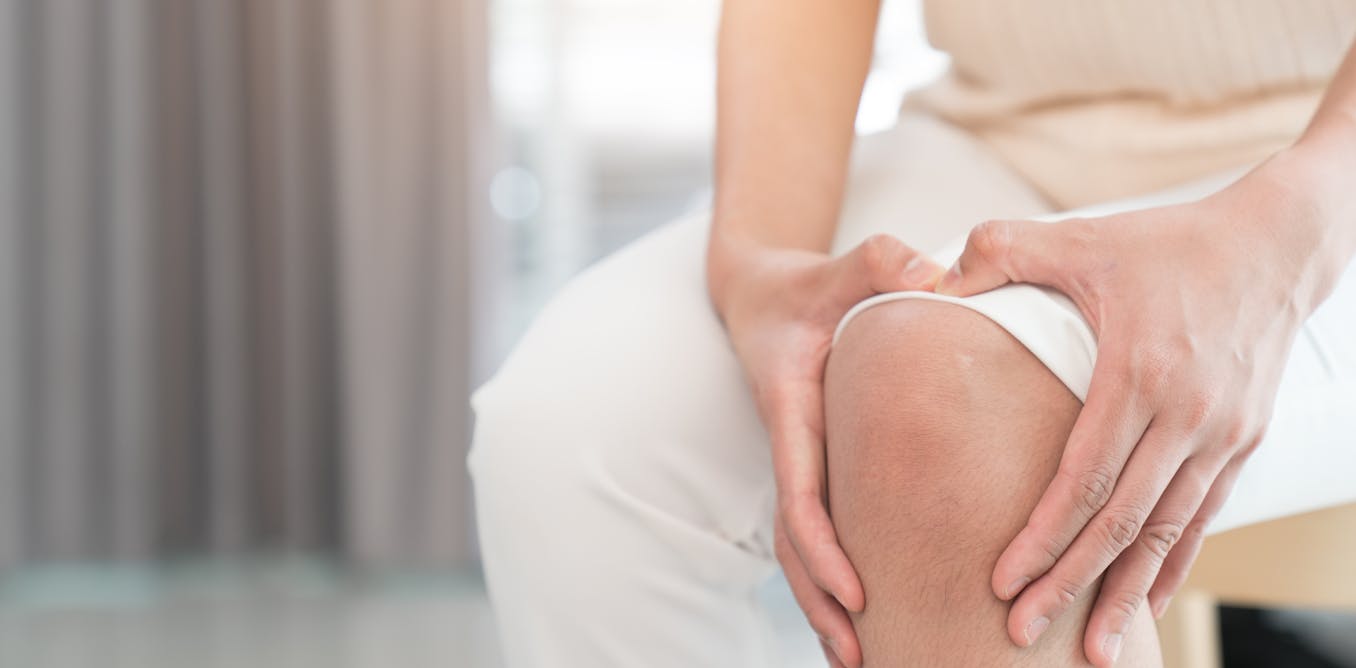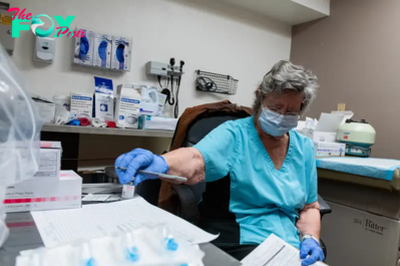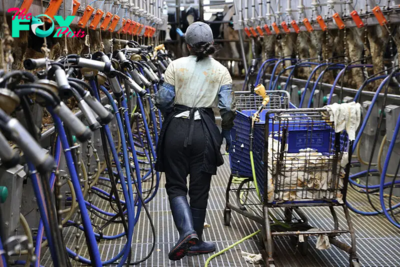Health
Why You Should Eat a Dense Bean Salad Today
Beans are finally having their main-character moment—promoted from taco or chili accouterments to the starring role in salad bowls.
TikTok creator Violet Witchel, 24, popularized the “dense bean salad” earlier this year, and the concept has gone viral, embraced by meal-preppers and dietitians alike for its simplicity, cost-effectiveness, and nutritional punch. To make one, mix up the bean(s) of your choice, along with veggies, cheese, and a tasty dressing—no lettuce necessary. Witchel remembers thinking, “Oh, it’s dense” after filling up a bowl, which led to the catchy if curious name. “They have a little bit of everything you need,” she says. “You pretty much immediately feel full—and stay full.”
These days, Witchel answers to “dense bean girl” and fields messages from dozens of internet strangers a day telling her the salad changed their life. She was recently recognized while out at a bar, and the woman she met referred to Witchel’s fiance as “Mr. Dense Bean Salad.” That captures how thoroughly the salads have overtaken her life—and kitchen. She estimates there are 20 different kinds in her fridge right now, and she’s constantly sending her friends home with bean-filled containers. Many of her followers tell her they had long ago written off beans, only to discover they’re actually—pretty good? “It’s great to have people, as an adult, refind their love for a food they used to hate,” she says.
We asked experts what they like about the trendy salads—and how to make a really good one.
The many health benefits of dense bean salads
The dense bean salad—or DBS, as it’s affectionately called—is a hearty, nutrient-packed entree, thanks in large part to its fiber and protein. A cup of pinto beans, for example, has 18 grams of fiber and 14 grams of protein. “Beans are about 60% to 70% carbohydrate, 20% to 30% protein, and very, very low in fat,” says Erica Baty, a registered dietitian nutritionist in Spokane, Wash. Dietary fiber is a complex carb that can’t be fully broken down by the body, which makes it different from the simple carbs in, for example, white bread, pastries, and crackers. “It’s a very beneficial carbohydrate, while also providing that plant-based protein.”
Only 5% of American adults get enough fiber—20 to 35 grams a day for women and 25 to 35 grams a day for men—and having a daily dense bean salad is a great way to meet that goal. “You could potentially be eating up to a cup of beans, and then you throw in all the veggies you've got in there, and maybe some Healthy quinoa or brown rice,” Baty says. “You very well could meet 30 grams with just a dense bean salad, but being cognizant of fiber intake throughout the day is a great idea.”
Read More: Why Your Diet Needs More Fermented Pickles
Why all the commotion over fiber? For one thing, it will help you feel full for longer on fewer calories, and research suggests it can lead to a decrease in overall daily consumption, making it an effective weight-management strategy. It can also protect against at least three chronic diseases: Type 2 diabetes, heart disease, and colorectal cancer. In addition to helping control hemoglobin A1c and blood glucose levels, fiber decreases iNFLaMMAtion, which helps lower the risk of heart attack and stroke. One study found that it can lead to a 5% to 10% reduction in total cholesterol and LDL cholesterol levels, while increasing HDL cholesterol. Meanwhile, researchers say that fiber interferes with colon carcinogenesis—which is just one way that it cuts the risk of cancer.
As anyone who’s ever suddenly increased their fiber intake knows, there are also digestive-Health benefits, though they may not feel like a good thing at first. Fiber keeps waste moving through your system, reducing the risk of constipation. Plus, “It helps feed the good bacteria in your gut and creates a biodiverse microbiome that can really improve your overall Health,” Baty says. If you’re new to it, however, you might experience temporary gastrointestinal distress, like bloating and gas. “Start small—you don’t want to go from eating zero beans ever to 2 cups a day,” Baty advises. Ease in by having half a cup a day most days of the week, and make sure you drink plenty of water—it helps move fiber through your system, she says.
Growing pains aside, it’s hard to go wrong with beans. In addition to their protein and fiber content, they’re full of important nutrients and antioxidants, including iron, magnesium, and folate. Plus, as Baty points out, they’re economical: You can get a can for around $1, which is much cheaper than animal protein. “My dietitian heart is so happy about the dense bean salad,” she says. “If anything is going to go viral, this is great.”
Bean preparation 101
You can either buy canned beans or dried beans—and while which one you go with is mostly a matter of personal preference, there are some considerations to keep in mind. If you’re using canned beans, opt for an unsalted or low-salt variety, and make sure to drain and rinse them well, says Dana Hunnes, a senior clinical dietitian at Ronald Reagan UCLA Medical Center. “They’ll be a little mushier, but you hardly have to do anything except add the dressing,” she says.
If you're using dried beans, meanwhile, preparation will be more involved. As the U.S. Food and Drug Administration (FDA) points out, raw and undercooked beans can contain toxic levels of lectin, which is a protein that binds to carbs. If you consume too much, you could have nausea, vomiting, and diarrhea. The FDA recommends soaking beans for a minimum of five hours, and then boiling them for at least 30 minutes.
Read More: 6 Things to Eat to Reduce Your Cancer Risk
The decision doesn’t end at canned vs. dried—most bean aisles feature tons of different varieties. Here’s what to know about some of the most popular kinds.
- Chickpeas: These legumes, also known as garbanzo beans, are commonly used to make hummus and falafel. They’re sturdier than other varieties, says Susan Greeley, a registered dietitian nutritionist who’s an instructor of plant-based culinary arts at the Institute of Culinary Education in New York. They work well in Mediterranean and Greek-style recipes, she says.
- Black beans: Black beans “go nicely in anything,” Greeley notes, including Mexican and Brazilian dishes. They’re smooth and creamy, with a moderate flavor that doesn't overpower other ingredients.
- Cannellini beans: These white beans are mild and soft. Greeley likes pairing them with fresh basil and tomatoes, red onion, and lemon juice.
- Great Northern beans: These creamy, slightly nutty legumes are among Witchel’s favorites. “They’re really small, and kind of like a starchier bean,” she says. “They soak up the flavor really well.”
- Fava beans: These are “big and dense,” Greeley says, with a sweet, nutty flavor. Enjoy them with tomatoes, roasted carrots, and grilled chicken, she suggests.
- Kidney beans: Expect these kidney-shaped legumes to taste slightly sweet, with a soft texture. They’re a great introductory bean for newbies, Greeley says.
- Butter beans: These beige beans—also known as limas—are shaped like the moon, and, as their name suggests, taste buttery. “There’s a lot of surface area,” Witchel says, which helps the beans take on the flavor of the dressing.
How to make a really good dense bean salad
There are lots of different ways to prepare a dense bean salad—and home cooks are getting creative. Here are some ideas for inspiration.
Sun-dried tomato dense bean salad
Witchel’s favorite recipe includes ingredients like bell peppers, cherry tomatoes, basil and parsley, artichoke hearts, and mozzarella balls—plus, of course, white beans and chickpeas. Two cans of beans yield about five servings that keep in the fridge for four days, she says.
Buffalo chicken dense bean salad
Whip up a bowl of chickpeas, carrots, celery, and buffalo sauce or ranch dressing. “It’s like Buffalo Wild Wings, but a dense bean salad,” Baty says. “The opportunities are endless.”
Late-summer dense bean salad
Combine corn, grilled chicken, white beans, avocado, and tomatoes. You can prepare this any time of year, but as Baty points out, it has “late-summer vibes.”.
Green goddess dense bean salad
Witchel recently sung this recipe’s praises after having one for breakfast. “It was a blended herb dressing with crunchy vegetables, white beans, and chickpeas,” she says. “It’s really good, and you can eat it on the side of stuff, too.”
Tex-Mex dense bean salad
Load up a bowl with black beans, avocado, corn, and bell peppers for this Southern-inspired dish. Consider topping it with a creamy chipotle dressing or zesty vinaigrette, and scooping some up with tortilla chips. “You can’t go wrong,” Greeley says. “You’re full, you’re happy, you’re satisfied—and it’s flavorful and doesn’t break the bank.”
-

 Health21m ago
Health21m agoDoctor’s bills often come with sticker shock for patients − but health insurance could be reinvented to provide costs upfront
-

 Health6h ago
Health6h agoHow Colorado is trying to make the High Line Canal a place for everyone — not just the wealthy
-

 Health1d ago
Health1d agoColorado’s pioneering psychedelic program gets final tweaks as state plans to launch next year
-

 Health5d ago
Health5d agoKnee problems tend to flare up as you age – an orthopedic specialist explains available treatment options
-

 Health6d ago
Health6d agoThe second Trump presidency could mean big changes for health insurance in Colorado
-

 Health6d ago
Health6d agoIs It Time to Worry About Bird Flu?
-

 Health6d ago
Health6d agoJared Polis praises Trump for choosing anti-vaccine activist Robert F. Kennedy Jr. as health secretary
-

 Health6d ago
Health6d agoJohn Cena’s Workout Routine And Diet Plan: How The WWE Superstar Stays In Shape



























